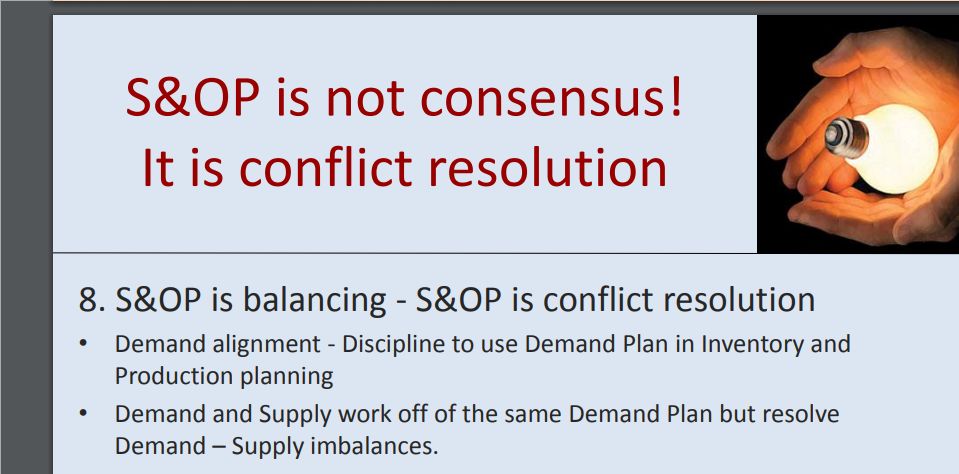S&OP is NOT about achieving consensus with your supply planning team!
The term "consensus" is often misinterpreted. The process of driving to Consensus is more important than achieving a single number that everyone agrees on.
Driving to Consensus also results in the discovery of many challenges that need resolutions - this makes the Sales and Operations Planning process more effective. The S&OP process is not about consensus - every one agreeing on the Plan. In fact, if you have an easy Consensus in your S&OP, it may not be a working process.
It is not about achieving consensus with the supply planners for your Demand Plan. Supply evaluation of the Demand Plan is the subject of the MPS and S&OP Process. Rarely will they ever agree with the demand plan - if they do, then you most likely have a lot of unsold inventory and obsolete inventory.
One of the worst practices I have seen is the Sales Team and the Supply Chain Team discussing the differences between the Sales Forecast and the Supply-chain forecast put together by the Supply Planning team. Consensus on the wrong forecast between the wrong parties...
S&OP is about conflict resolution - go to the meeting every month to understand where the conflict is; where you have a demand-supply imbalance. Highlight demand-supply imbalances that need to be analyzed, discussed, and resolved with potential solutions either demand-driven or supply-driven.
Conflicts may arise with in the demand side or when demand is evaluated by the supply planners.
Demand-side conflicts:
1. Demand Forecast not meeting the Latest Estimate or Budget
2. Demand Forecast too high compared to the Revised Budget
3. Demand Forecast for supply chain is significantly different from the Financial Forecast - Say the dollarized forecast is 10% above the Sales Forecast
4. Sales Input given to Demand Planning results in a lofty Demand Forecast that Supply planning could not meet.
Demand-Supply Conflicts:
1. Demand Forecast inflates the Supply requirement however the financial commitment to Management is much lower. The issue of sales sandbagging the financial forecast but inflating the Unit forecast at the SKU level to ensure adequate supply of all products. This will have an undesired consenquence of supply signals being blurred. If capacity is limited, supply chain may have to ration the capacity to specific prdoucts or all products. Lack of Demand clarity will result in stock outs.
2. Demand Plan provides better clarity and visibility to demand in the short-run but very poor visibility to the period outside the three month window. Supply Planning has to make its own forecast for the mid-term and long-term to procure raw materisl that have a longer lead time.
3. Sales Function changes the forecast considerably within the short-term frozen window. Supply Planning has to re-adjust their plans and spend considerable amount of time and energy on tactical planning - in essence fire fighting to meet the demand. This is the issue of Demand Side not having a longer term forecast horizon.
Feel free to download a brief presentation on S&OP building blocks. - Click here


Leave a Reply